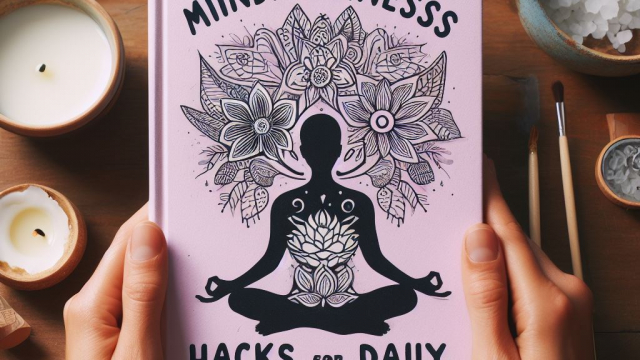
In our busy modern lives, it can be challenging to slow down, take a breath, and be fully present. Practicing mindfulness is one of the most powerful things you can do to enhance your mental and physical well-being, even with a packed schedule.
This comprehensive guide shares 15 simple yet profound mindfulness hacks you can easily incorporate into your daily routine. Integrate these techniques to reduce stress, increase focus, and experience a total mind-body revival.
What is Mindfulness?
Mindfulness means purposefully paying attention to the present moment without judgment. It involves tuning into your thoughts, feelings, and sensations in the here and now.
Originating from ancient Buddhist teachings, mindfulness is now commonly used in mainstream wellness practices. Research shows it provides tremendous benefits for both mental and physical health.
Mindfulness helps you:
- Reduce anxiety and depression
- Improve focus and concentration
- Strengthen your immune system
- Sleep better
- Increase self-awareness
- Build resilience to life’s challenges
Practicing mindfulness does not require extensive training or lots of time. You can cultivate greater mindfulness through simple, everyday habits.
Here are 15 easy yet highly effective mindfulness hacks to try:
1. Set Reminders to Pause
Perhaps the most basic mindfulness habit is to periodically pause whatever you are doing and check in with yourself.
Set reminders on your phone, computer, or watch to pause for 1-2 minutes every hour. When the alarm sounds:
- Stop work or any task you are doing.
- Close your eyes and take a few deep breaths.
- Observe how your mind and body feel in that moment.
- Refocus your attention fully on the present.
Build this basic mindfulness reset into your workday and other routines. It quickly reignites mental clarity and focus.
2. Practice Mindful Dishwashing
Washing dishes is typically an automated, mindless chore. Make it a mini mindfulness meditation instead!
When washing your dishes, avoid rushing through it on autopilot. Bring complete attention to the sensory experiences:
- Feel the water temperature and soap bubbles.
- Listen to the sounds of splashing water.
- Notice the smell of the dish soap.
- Observe the mind’s tendency to drift into daydreams. When it does, gently bring your focus back to the sensations of dishwashing.
This transforms an everyday task into a powerful mindfulness practice.
3. Set a Daily Mindfulness Anchor
Choose a daily activity to serve as your mindfulness anchor, a consistent prompt to become more present.
Good mindfulness anchors include:
- Brushing your teeth
- Your first cup of coffee or tea
- Your walk to work
- Waiting for the bus or train
Each time you do this activity, use it as a cue to pay close attention to the experience. Notice thoughts, physical sensations, and emotions with open curiosity, as if for the first time.
Establishing a mindfulness anchor integrates presence into your day effortlessly.
4. Go on Mindful Commutes
Make your daily commute mindfulness time. If driving, turn off any music, podcasts, or talk radio. Bring full attention to the act of driving—the feel of your hands on the wheel, sensations in your body, and your breathing. Soak in your surroundings as they pass by.
On public transit, focus on the people around you or the sights out the window. Silently observe thoughts and feelings as they come and go without judging them.
Practicing mindfulness during your commute replaces autopilot and spacing out with profound presence.
5. Do a Quick Body Scan
Check in with your body throughout the day with a quick body scan.
- Sit or stand comfortably with your eyes closed or your gaze lowered softly.
- Start by bringing attention to the physical sensations in your feet and toes. Notice any tightness, tension, warmth, or pulsing.
- Slowly move your focus up body—legs legs, hips, torso, hands, arms, and shoulders. Observe how each area feels.
- Move up through your neck, jaw, face, head, and scalp.
- Scan for any area of your body calling for movement or stretching. Gently deepen your breath to release any tension or discomfort.
Body scans cultivate a greater connection between your mind and body. Make them a daily ritual.
6. Listen to Nature
Next time you go outside, devote your full attention to carefully listening for a few minutes. Turn toward natural sounds, which we often overlook:
- Wind-rustling trees
- Birds singing
- Insects buzzing
- Your footsteps along a sidewalk or trail
As thoughts arise, acknowledge them briefly, then return focus to listening intently. This simple nature immersion quickly settles a restless mind.
7. Practice Mindful Tasting
Make mealtimes an exercise in mindfulness by slowing down to truly taste each bite. Sit down without distractions. Before eating, observe the colors and textures on your plate.
As you begin eating, focus completely on the sensory experience.
- Appreciate the aromas before taking a bite.
- Notice flavors and textures as you chew.
- Tune into the physical sensations of swallowing.
- Pause between bites or eat with your non-dominant hand to prevent rushing.
This transforms eating from a mindless rush into quality time with yourself.
8. Observe Your Emotions
Our emotions often fluctuate throughout the day, sometimes rapidly shifting from one to the next. Practice observing your emotions from a neutral witness perspective:
- What emotions arise as you go about your day? Name them without judgment.
- Notice any physical sensations related to specific emotions—tightness, flutters, warmth, etc.
- Acknowledge and accept your emotions with compassion rather than resisting or suppressing them.
- Refrain from over-identifying with emotions or believing thoughts that accompany them.
- Allow emotions to subside as naturally as they arise.
Developing emotional awareness reduces reactivity. It helps you respond thoughtfully to situations that trigger you.
9. Set a Daily Intention
Choose a focus for your day ahead—your daily intention. State it positively in the present tense:
- “Today I am patient.”
- “Today I see beauty around me.”
- “Today I am grounded.”
Repeat this mantra silently throughout your day. Use it as a touchstone to return to your intention, especially during challenges. Reflect on it before bed to appreciate manifestations from your day.
This ritual channels mindfulness into a powerful tool for manifestation.
10. Find Micro-Mindfulness Moments
Look for dozens of potential micro-mindfulness moments throughout your average day.
- Waiting in line
- Brushing your hair
- Washing your hands
- Chopping vegetables
- Folding laundry
- Walking the dog
Insert 10–60 seconds of mindful presence during simple daily activities. Fully immerse yourself in the sights, textures, smells, and sensations.
These micro-moments cultivate mindfulness muscles you can flex anytime, anywhere.
11. Practice Loving-Kindness Meditation
This meditation strengthens self-compassion and positive feelings toward others through the silent repetition of mantras. Sit comfortably and visualize each person as you repeat the mantras:
- For yourself: “May I be happy. May I be healthy? May I be safe from harm.”
- For a loved one: “May you be happy. May you be healthy. May you be safe from harm.”
- For a neutral person, repeat the same mantra.
- For a difficult person, repeat the mantra.
- For all beings everywhere: “May all beings be happy. May all beings be healthy. May all beings be safe from harm.”
Conclude by resting silently. Repeat this practice daily to transform relationships.
12. Mindfully Move Your Body
Apply mindfulness to exercise by dropping the distraction of screens, music,, or books. Silently observe the physical sensations of movement:
- Walking – the rhythmic motion, pressures through feet, the breeze on the skin
- Yoga – the stretch of muscles, flow between poses
- Weightlifting – the heft of the weights, the grip on the barbell
- Sports – the qualities of different motions, and positions of your limbs in space
Adding a mindful, meditative element to movement amplifies benefits.
13. Practice STOP Mindfulness
Use the acronym S.T.O.P. to redirect your attention in moments of stress:
S = Stop what you are doing. Pause and take a breath.
T = Take a step back. Put distance between you and what is triggering you.
O = Observe what is happening inside right now. Name your thoughts, emotions, and sensations without judging them.
P = Proceed mindfully. After this brief reset, you can choose how to respond rather than just react.
Having a simple process to return to presence is enormously valuable during difficult times.
14. Prioritize Mindfulness First Thing
Rather than immediately diving into work or digital distractions, take the first 10–30 minutes of your day to orient yourself consciously.
Mindfully transitioning into your day may include:
- Drinking a cup of tea
- Stretching
- Meditating
- Writing in your journal
- Looking out the window
This morning mindfulness ritual primes you for a calmer, more intentional day ahead.
15. Practice Mindful Tech Time
Apply extra awareness when engaging with your devices to prevent tech time from dominating your day.
- Notice the the impulse to reach for your phone; pause instead of reacting automatically.
- Set limits on scrolling time for apps that suck you in.
- Place your phone face down when working on projects requiring deep focus.
- Single task instead of splitting attention between tech and people.
- Look up and take eye breaks from screens every 20 minutes.
Making technology more conscious prevents it from mindlessly controlling you.
Key Takeaways on Mindfulness Hacks
- Integrating micro-moments of mindfulness throughout your day builds focus and well-being.
- From drinking tea to brushing your teeth, anchor mindfulness to daily routines.
- Practice mindful eating, commuting, exercise, and technology use.
- Notice thoughts, emotions, and bodily sensations in the present moment without judgment.
- Mindful breathing, body scans, meditation, mantras, and intention-setting reorient you to presence.
- Make mindfulness a priority first thing in the morning and during stress.
- Small, consistent efforts cultivate mindfulness muscles over time for a daily revival.
Conclusion
Adopting these mindfulness hacks empowers you to create space for awareness, even in a busy schedule. Choose techniques that feel accessible and enjoyable; mindfulness is a personalized journey. Refer back to this guide anytime you need inspiration or fresh approaches. Moment by moment, you can build mindfulness to elevate both mental and physical wellness.
Frequently Asked Questions on Mindfulness Hacks
What is the easiest mindfulness technique for beginners?
Mindful breathing is the most basic yet profoundly helpful mindfulness practice. Set a timer and simply observe each inhale and exhale, gently redirecting your attention whenever the mind wanders. Start with just 2–5 minutes.
When should I practice mindfulness during the day?
It’s ideal to start your day with mindfulness, such as a short meditation or yoga. But any time is a good time! Practice mindfulness on your lunch break, during your commute, or in micro-moments throughout your day.
Where can I learn more about mindfulness?
Look for mindfulness classes at local community centers, meditation studios, or wellness clinics. Apps like Headspace and Calm offer excellent guided meditations and mindfulness programs. Read books by mindfulness experts like Jon Kabat-Zinn, Thich Nhat Hanh, Sharon Salzburg, and Jack Kornfield.
What should I do if mindfulness feels frustrating?
It’s normal to struggle at first. Don’t judge yourself. Try shorter sessions focusing on your breath or body. Mindfulness takes practice; be patient with the process. Do what you can without forcing it. Any amount is beneficial.
How will I know if my mindfulness practice is working?
Over time, expect to feel less stressed, more focused at work, improved sleep, increased empathy and connection in relationships, and an overall sense of calm and balance. But mindfulness is about the journey, not the destination; trust the subtle positive changes unfolding.
Can mindfulness help manage depression or anxiety?
Research shows mindfulness can help reduce symptoms for some people, especially as part of professional treatment plans. However, severe cases may require therapy, medication, or both. Consult your doctor or mental health provider.
Incorporating small yet mighty mindfulness habits into your daily routine positively transforms mental and physical well-being over time. By fully embracing the present moment, you tap into a profound source of inner peace.



